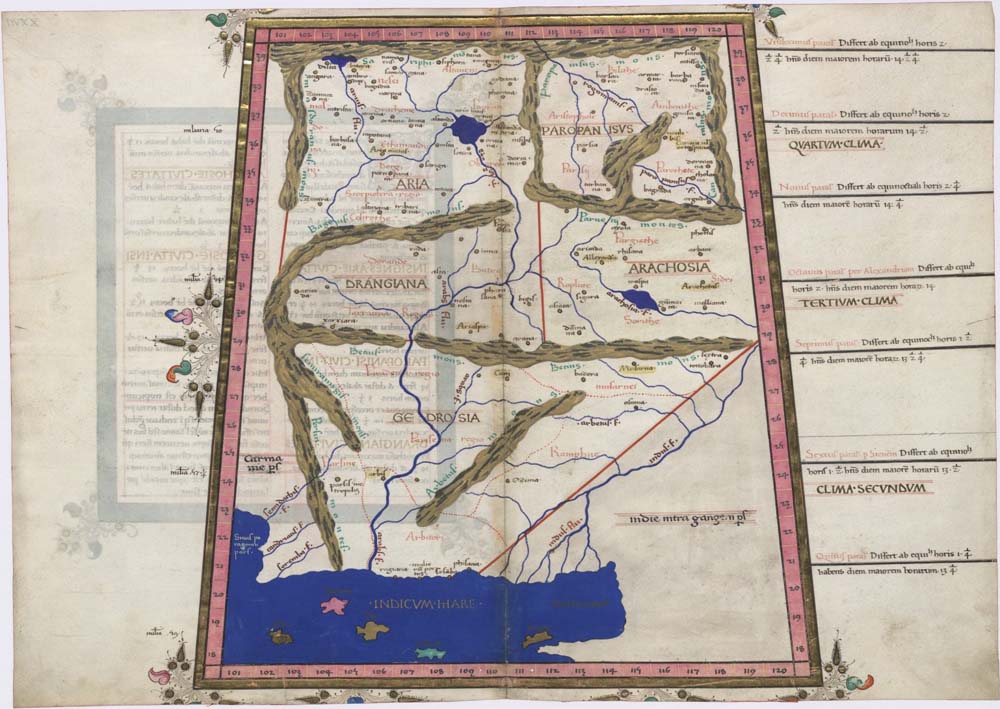|
Qasem-e Anvar
Mu'in al-Din Ali Husayni Sarabi Tabrizi, commonly known by his ''laqab'' (honorific title) of Qasim-i Anvar ( fa, قاسم انوار; 1356 – 1433) was a Sufi mystic, poet, and a leading ''da'i'' (preacher) of the Safavid order. Biography Born in 1356 in Sarab in the Azerbaijan region, According to the historians H. Javadi and K. Burrill / ''Encyclopædia Iranica'', Mu'in al-Din Ali was a native speaker of Azeri Turkish, while the historians Siavash Lornejad and Ali Doostzadeh state that he was most likely a native speaker of Fahlavi. Mu'in al-Din Ali preferred to use Persian, which he was fluent in. He grew up in the neighbouring city of Tabriz, where he received his education. In his mid-teens, he became a disciple of Sadr al-Din Musa (died 1391), who was the head of the Safavid order. Due to a vision seen by Mu'in al-Din Ali, he was given the ''laqab'' (honorific title) Qasim-i Anvar ("Distributor of Lights") by Sadr al-Din Musa. Following his completion of his traini ... [...More Info...] [...Related Items...] OR: [Wikipedia] [Google] [Baidu] |
Diwan (poetry)
In Islamic culture Islamic culture and Muslim culture refer to cultural practices which are common to historically Islamic people. The early forms of Muslim culture, from the Rashidun Caliphate to the early Umayyad period and the early Abbasid period, were predomi ...s of the Middle East, North Africa, Sicily and South Asia, a Diwan ( fa, دیوان, ''divân'', ar, ديوان, ''dīwān'') is a collection of Poetry, poems by one author, usually excluding his or her long poems (Mathnawi (poetic form), mathnawī). The vast majority of Diwan poetry was Lyric poetry, lyric in nature: either ghazals or ''gazel''s (which make up the greatest part of the repertoire of the tradition), or ''kasîde''s. There were, however, other common genres, most particularly the ''mesnevî'', a kind of Courtly romance, verse romance and thus a variety of narrative poetry; the two most notable examples of this form are the ''Layla and Majnun'' (ليلى و مجنون) of Fuzûlî and the ''Hüsn ... [...More Info...] [...Related Items...] OR: [Wikipedia] [Google] [Baidu] |
Khirqa
The khirqa is the initiatory cloak of the Sufi chain of spirituality, with which esoteric knowledge and barakah is passed from the Murshid or the Shaikh to the aspirant murid. The khirqa initiates an aspirant into the silsilah, the chain or lineage of sheikhs that goes back to the Islamic prophet, Muhammad. This chain serves as the channel through which barakah flows from the source of spiritual revelation to the being of the initiate. Subdivisions There are two kinds of this kind of transmission (tanakkul) of barakah through the khirqa: khirqa-yi irada and khirqa-yi tabarruk. Khirqa-yi irada is characterized by the passing of barakah to the aspirant from the singular sheikh to which they have pledged allegiance ( bay'at). Khirqa-yi tabarruk, also known as the "frock of blessing", is characterized by the passing of barakah to the worthy aspirant from any sheikh that they have encountered. The silsilah chain created from the passing of the khirqa that confirms authenticity of m ... [...More Info...] [...Related Items...] OR: [Wikipedia] [Google] [Baidu] |
Persian-language Poets
Persian (), also known by its endonym Farsi (, ', ), is a Western Iranian language belonging to the Iranian branch of the Indo-Iranian subdivision of the Indo-European languages. Persian is a pluricentric language predominantly spoken and used officially within Iran, Afghanistan, and Tajikistan in three mutually intelligible standard varieties, namely Iranian Persian (officially known as ''Persian''), Dari Persian (officially known as ''Dari'' since 1964) and Tajiki Persian (officially known as ''Tajik'' since 1999).Siddikzoda, S. "Tajik Language: Farsi or not Farsi?" in ''Media Insight Central Asia #27'', August 2002. It is also spoken natively in the Tajik variety by a significant population within Uzbekistan, as well as within other regions with a Persianate history in the cultural sphere of Greater Iran. It is written officially within Iran and Afghanistan in the Persian alphabet, a derivation of the Arabic script, and within Tajikistan in the Tajik alphabet, a deriva ... [...More Info...] [...Related Items...] OR: [Wikipedia] [Google] [Baidu] |
Azerbaijani-language Poets
The following is a List of Azerbaijani-language poets. North Azerbaijan * Ashig Alasgar * Mammad Araz *Hamid Arzulu *Aşık Khanlar *Babi Badalov * Abbasgulu Bakikhanov *Vagif Bayatly Oner *Mirvarid Dilbazi * Piruz Dilenchi * Teymur Elchin *Fuzûlî *Fikrat Goja * Madina Gulgun *Mahammad Hadi *Izzeddin Hasanoglu *Almas Ildyrym *Hamlet Isakhanli * Jafar Jabbarly * Jafargulu agha Javanshir *Ahmad Javad * Huseyn Javid *Nusrat Kasamanli * Mikayil Mushfig * Imadaddin Nasimi * Khurshidbanu Natavan *Ali Nazmi * Mammed Said Ordubadi *Baba Punhan *Ramiz Rovshan *Suleyman Rustam *Mirza Alakbar Sabir *Abbas Sahhat *Bahar Shirvani *Seyid Azim Shirvani * Khalil Rza Uluturk *Mehdigulu Khan Vafa * Molla Panah Vagif * Bakhtiyar Vahabzadeh *Aliagha Vahid * Mirza Shafi Vazeh *Molla Vali Vidadi * Samad Vurgun *Gasim bey Zakir *Hikmat Ziya Iranian Azerbaijan * Piruz Dilenchi * Madina Gulgun *Habib Saher * Mohammad-Hossein Shahriar References {{DEFAULTSORT:Azerbaijani-language poets Azerbaijani- ... [...More Info...] [...Related Items...] OR: [Wikipedia] [Google] [Baidu] |
Gilaki Language
The Gilaki language ( ) is an Iranian languages, Iranian language of the Northwestern Iranian languages, Northwestern branch, spoken in Iran's Gilan Province. Gilaki is closely related to Mazandarani language, Mazandarani and the two languages have similar vocabularies. Though the Persian language has influenced Gilaki to a great extent, Gilaki remains an independent language with a northwestern Iranian origin. The Gilaki and Mazandarani languages (but not other Iranian languages) share certain typological features with Caucasian languages (specifically South Caucasian languages),Academic American Encyclopedia By Grolier Incorporated, page 294The Tati language group in the sociolinguistic context of Northwestern Iran and Transcaucasia By D.Stilo, pages 137-185 reflecting the history, ethnic identity, and close relatedness to the Caucasus region and Peoples of the Caucasus, Caucasian peoples of the Gilaki people, Gilak people and Mazandarani people. Classification The language ... [...More Info...] [...Related Items...] OR: [Wikipedia] [Google] [Baidu] |
Mathnawi
Mathnawi ( ar, مثنوي ''mathnawī'') or masnavi ( fa, مثنوی) is a kind of poem written in rhyming couplets, or more specifically "a poem based on independent, internally rhyming lines". Most mathnawī poems follow a meter of eleven, or occasionally ten, syllables, but had no limit in their length. Typical mathnawi poems consist of an indefinite number of couplets, with the rhyme scheme aa/bb/cc. Mathnawī poems have been written in Persian, Arabic, Turkish, Kurdish and Urdu cultures. Certain Persian mat̲h̲nawī poems, such as Rumi’s '' Masnavi-e Ma’navi'', have had a special religious significance in Sufism. Arabic mat̲h̲nawī Arabic mathnawi poetry, also known as ''muzdawidj'' ( ar, مزدوج, literally "doubled," referring to the internal rhyme scheme of the lines), emerged and was popularized during the Abbasid era. Unlike the older poetic styles in Arabic, mathnawi verses are not monorhymes. Instead, they include an internal rhyme scheme within each bayt ... [...More Info...] [...Related Items...] OR: [Wikipedia] [Google] [Baidu] |
Ghazals
The ''ghazal'' ( ar, غَزَل, bn, গজল, Hindi-Urdu: /, fa, غزل, az, qəzəl, tr, gazel, tm, gazal, uz, gʻazal, gu, ગઝલ) is a form of amatory poem or ode, originating in Arabic poetry. A ghazal may be understood as a poetic expression of both the pain of loss or separation and the beauty of love in spite of that pain. The ghazal form is ancient, tracing its origins to 7th-century Arabic poetry. The ghazal spread into South Asia in the 12th century due to the influence of Sufi mystics and the courts of the new Islamic Sultanate, and is now most prominently a form of poetry of many languages of the Indian subcontinent and Turkey. A ghazal commonly consists of five to fifteen couplets, which are independent, but are linked – abstractly, in their theme; and more strictly in their poetic form. The structural requirements of the ghazal are similar in stringency to those of the Petrarchan sonnet. In style and content, due to its highly allusive nature, ... [...More Info...] [...Related Items...] OR: [Wikipedia] [Google] [Baidu] |
Ulugh Beg
Mīrzā Muhammad Tāraghay bin Shāhrukh ( chg, میرزا محمد طارق بن شاہ رخ, fa, میرزا محمد تراغای بن شاہ رخ), better known as Ulugh Beg () (22 March 1394 – 27 October 1449), was a Timurid sultan, as well as an astronomer and mathematician. Ulugh Beg was notable for his work in astronomy-related mathematics, such as trigonometry and spherical geometry, as well as his general interests in the arts and intellectual activities.Science in Islamic civilisation: proceedings of the international symposia: "Science institutions in Islamic civilisation", & "Science and technology in the Turkish and Islamic worl/ref> It is thought that he spoke five languages: Arabic, Persian, Turkic, Mongolian, and a small amount of Chinese. During his rule (first as a governor, then outright) the Timurid Empire achieved the cultural peak of the Timurid Renaissance through his attention and patronage. Samarkand was captured and given to Ulugh ... [...More Info...] [...Related Items...] OR: [Wikipedia] [Google] [Baidu] |
Samarkand
fa, سمرقند , native_name_lang = , settlement_type = City , image_skyline = , image_caption = Clockwise from the top: Registan square, Shah-i-Zinda necropolis, Bibi-Khanym Mosque, view inside Shah-i-Zinda, Sher-Dor Madrasah in Registan, Timur's Mausoleum Gur-e-Amir. , image_alt = , image_flag = , flag_alt = , image_seal = Emblem of Samarkand.svg , seal_alt = , image_shield = , shield_alt = , etymology = , nickname = , motto = , image_map = , map_alt = , map_caption = , pushpin_map = Uzbekistan#West Asia#Asia , pushpin_map_alt = , pushpin_mapsize = 300 , pushpin_map_caption = Location in Uzbekistan , pushpin_label_position = , pushpin_relief = 1 , coordinates = , coor_pinpoint = ... [...More Info...] [...Related Items...] OR: [Wikipedia] [Google] [Baidu] |
Ulama
In Islam, the ''ulama'' (; ar, علماء ', singular ', "scholar", literally "the learned ones", also spelled ''ulema''; feminine: ''alimah'' ingularand ''aalimath'' lural are the guardians, transmitters, and interpreters of religious knowledge in Islam, including Islamic doctrine and law. By longstanding tradition, ulama are educated in religious institutions ''(madrasas)''. The Quran and sunnah (authentic hadith) are the scriptural sources of traditional Islamic law. Traditional way of education Students do not associate themselves with a specific educational institution, but rather seek to join renowned teachers. By tradition, a scholar who has completed his studies is approved by his teacher. At the teacher's individual discretion, the student is given the permission for teaching and for the issuing of legal opinions ''(fatwa)''. The official approval is known as the '' ijazat at-tadris wa 'l-ifta'' ("license to teach and issue legal opinions"). Through time, ... [...More Info...] [...Related Items...] OR: [Wikipedia] [Google] [Baidu] |
Herat
Herāt (; Persian: ) is an oasis city and the third-largest city of Afghanistan. In 2020, it had an estimated population of 574,276, and serves as the capital of Herat Province, situated south of the Paropamisus Mountains (''Selseleh-ye Safēd Kōh'') in the fertile valley of the Hari River in the western part of the country. An ancient civilization on the Silk Road between the Middle East, Central and South Asia, it serves as a regional hub in the country's west. Herat dates back to Avestan times and was traditionally known for its wine. The city has a number of historic sites, including the Herat Citadel and the Musalla Complex. During the Middle Ages Herat became one of the important cities of Khorasan, as it was known as the ''Pearl of Khorasan''. After the conquest of Tamerlane, the city became an important center of intellectual and artistic life in the Islamic world. Under the rule of Shah Rukh the city served as the focal point of the Timurid Renaissance, ... [...More Info...] [...Related Items...] OR: [Wikipedia] [Google] [Baidu] |








